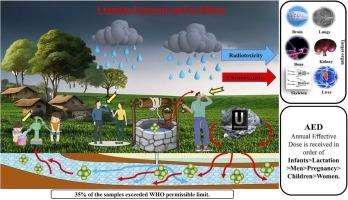南印度潘巴尔河流域Sevathur矿区年龄依赖性地质辐射暴露和致癌风险评价
IF 11.3
1区 环境科学与生态学
Q1 ENGINEERING, ENVIRONMENTAL
引用次数: 0
摘要
本研究调查了印度南部潘巴尔河流域的地下水铀污染和放射性风险,该地区受碳酸盐岩地层影响,地质辐射显著。铀浓度范围从5.8到240.8 μg L⁻¹,35%的样本超过了世界卫生组织30 μg L⁻¹的限制。年有效剂量从7.22 μSv - 604.36 μSv - 1不等,对婴儿有较高的危险。尽管有这些发现,癌症死亡率和发病率风险仍然低于允许的阈值,分别为6.29 × 10 - 5和9.15 × 10 - 5。铀与总溶解固形物(TDS)之间的强相关性突出了地质和人为因素的影响。岩石学和地球化学分析显示,碳酸盐岩中含有富铀的焦绿石矿物,平均铀浓度为14.08 mg kg⁻¹。这项研究强调需要在受铀影响的矿区进行主动的地下水监测和管理,为放射性健康风险和地质污染过程提供见解。本文章由计算机程序翻译,如有差异,请以英文原文为准。

Appraisal of age-dependent geogenic radiation exposure and carcinogenic risks in the groundwater of Sevathur mine region, Pambar River basin, South India
This study investigates groundwater uranium contamination and radiological risks in a part of Pambar River basin, South India, a region with significant geogenic radiation influenced by carbonatite rock formations. Uranium concentrations ranged from 5.8 to 240.8 μg L⁻¹ , with 35 % of samples exceeding the WHO limit of 30 μg L⁻¹ . Annual effective doses varied from 7.22 to 604.36 μSv y⁻¹ , posing higher risks to infants. Despite these findings, cancer mortality and morbidity risks remained below the permissible thresholds, with values of 6.29 × 10−5 and 9.15 × 10−5, respectively. A strong correlation between uranium and total dissolved solids (TDS) highlights the influence of geogenic and anthropogenic factors. Petrological and geochemical analyses revealed uranium-rich pyrochlore minerals in carbonatite rocks, with an average uranium concentration of 14.08 mg kg⁻¹ . This study emphasizes the need for proactive groundwater monitoring and management in uranium-affected regions, providing insights into radiological health risks and geogenic contamination processes.
求助全文
通过发布文献求助,成功后即可免费获取论文全文。
去求助
来源期刊

Journal of Hazardous Materials
工程技术-工程:环境
CiteScore
25.40
自引率
5.90%
发文量
3059
审稿时长
58 days
期刊介绍:
The Journal of Hazardous Materials serves as a global platform for promoting cutting-edge research in the field of Environmental Science and Engineering. Our publication features a wide range of articles, including full-length research papers, review articles, and perspectives, with the aim of enhancing our understanding of the dangers and risks associated with various materials concerning public health and the environment. It is important to note that the term "environmental contaminants" refers specifically to substances that pose hazardous effects through contamination, while excluding those that do not have such impacts on the environment or human health. Moreover, we emphasize the distinction between wastes and hazardous materials in order to provide further clarity on the scope of the journal. We have a keen interest in exploring specific compounds and microbial agents that have adverse effects on the environment.
 求助内容:
求助内容: 应助结果提醒方式:
应助结果提醒方式:


